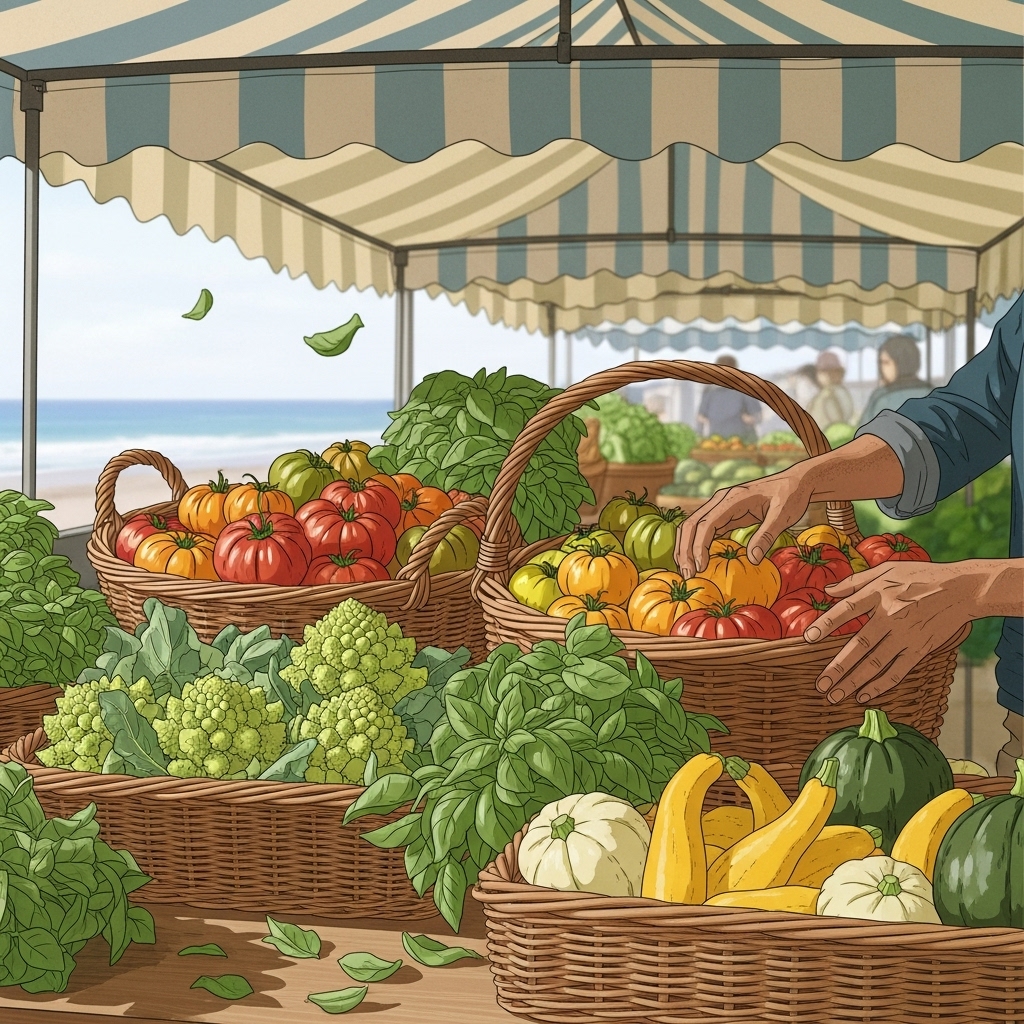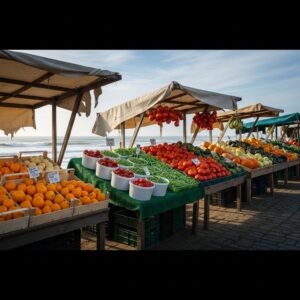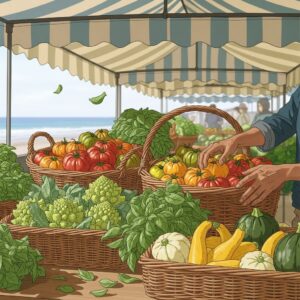In Malibu, the conversation about food starts with the wind and the water. Ocean air cools the canyons at night, the sun returns with intent by midmorning, and fields respond with a kind of vibrant calm you can taste in every leaf and fruit. When you choose organic at our fresh markets, you’re tasting more than a label; you’re tasting farming that protects the soil that cradles these hills and the coastal waters that define our home. That respect shows up in the details: strawberries that smell like warm sugar, lettuces that hold their crisp, and herbs so alive they perfume your car on the drive home. If you like to map your meals before the weekend, a quick scan of the weekly deals can nudge you toward what’s peaking organically right now, making it easier to build a plan that’s both practical and delicious.
Organic in Malibu is not a trend; it’s a commitment to place. Many of the growers who set up at our markets rotate crops, plant cover, and manage pests with the softest touch possible. They irrigate thoughtfully, compost scraps back into the soil, and lean on biodiversity to steady their fields through heat, wind, and the occasional drenching storm. You can hear that commitment when you ask about a crate of carrots or a stack of squash. Farmers will tell you how the marine layer saved a delicate planting or how a wind event taught them to stake trellises differently the following year.
Winter’s Organic Brightness
Winter is citrus poetry in Southern California, and our organic stalls overflow with mandarins, Cara Caras, and Meyer lemons. Each has a personality: mandarins peel like a promise and burst with floral sweetness; Cara Caras glow coral inside, a surprise that never gets old; Meyers carry a perfume that turns simple vinaigrettes into something you want to eat with a spoon. Alongside citrus, you’ll find hardy greens—kale, chard, collards—each leaf built from cold nights and clear mornings. Carrots pulled from soil after a chill taste almost caramelized, and beets roast into velvet.
Avocados reach their stride as winter deepens. The organic Hass that show up in January and February feel dense and buttery, ideal for slicing over toast with lemon and sea salt or cubing into salads brightened by grapefruit. You might also notice early broccoli and cauliflower, some with psychedelic spirals of romanesco, others tight and white like winter clouds. These are the vegetables that make warm soups and slow roasts feel inevitable, and that hold up across days so you can cook once and eat well all week.
Spring’s Organic Awakenings
Spring tastes like rain on herbs and sun on strawberries. The first organic berries arrive small and intensely fragrant, the kind you can smell from a stall away. Peas follow—sugar snaps that crack like tiny icicles, shelled peas sweet enough to eat raw, and tendrils that tangle into salads like poetry. Asparagus stands upright in buckets of cool water, its tips tight and dignified. Green garlic hints at summer’s approach, and tender lettuces—little gems, butterheads, frisée—invite you to rediscover the pleasure of salad.
With spring produce, I cook barely. I shave asparagus raw with lemon and olive oil, fold peas into warm pasta with mint, and pile strawberries into bowls with yogurt or toss with balsamic for a dinner that ends in a hush. Herbs multiply—basil, dill, parsley, cilantro—so I make a habit of blending a quick green sauce to spoon over grilled fish or roasted vegetables. Organic spring is not fussy; it’s exacting in its freshness, which means the less you do, the more it sings.
Summer’s Organic Opulence
Summer in Malibu is a parade of color. Tomatoes arrive in shapes that look like heirlooms remembered from a dream, each bite a balance of acidity and sugar that tastes like warm sunlight. Cucumbers snap and spill coolness; peppers go from grassy to sweet to faintly smoky; eggplants soak up olive oil and give back silk. Organic melons—charentais, galia, canary—carry perfume that hangs in the air even before you cut them. Stone fruit is the season’s drumbeat: peaches, nectarines, plums, apricots. The best ones bruise if you look at them too long, their tenderness both a hazard and a promise.
I like to eat summer food outside, where the breeze and the sun feel like part of the seasoning. Slice tomatoes and layer with basil, drizzle with oil and crack pepper; shave cucumbers thin, salt lightly, and toss with lemon; grill eggplants until the skins blister and the insides turn smoky and soft, then spoon tahini over the top. Berries keep coming, so I freeze a tray for smoothies and keep a bowl on the table for snacking. When corn peaks, I barely cook it—just a kiss of heat in the pan or on the grill, then into salads with tomatoes and herbs.
Fall’s Organic Calm
After summer’s crescendo, fall arrives like a deep breath. Figs appear first, honeyed and delicate, followed by apples with thin, crisp skins and a flavor that seems to hold the smell of the orchard. Persimmons come in two moods: Hachiyas, which turn custardy when soft, and Fuyus, which you can eat while firm, sliced into salads with a shower of lemon. Pomegranates crack open like jeweled puzzle boxes, arils scattering into yogurt, salads, or simply cupped in your palm. Squash varieties take over the stalls—kabocha with chestnut sweetness, delicata with edible skins, butternut for soup that hardly needs cream.
Fall cooking leans toward warmth: roast trays of roots, sauté chard with garlic, simmer beans with herbs, and finish dishes with the brightness of late-season citrus. It’s a rhythm that welcomes lingering dinners and second helpings, the kind of meals that make friends feel like family. In the background, avocados keep steady time, bridging seasons so there’s always a creamy counterpoint to crisp and sweet.
Organic Choices and the Coast
Choosing organic here feels like a handshake with the coast. It protects the riparian corridors that lead to the ocean and the pollinators that keep our markets alive with fruit. Ask growers about their practices and you’ll hear about beneficial insects, habitat buffers, and compost that smells like forest floor. You taste those choices in leaves that don’t wilt, fruit that holds juice without collapsing, and a vibrancy that turns a Tuesday dinner into a small event.
As a home cook, you become a steward too. You rinse greens in a basin and pour the water onto thirsty herbs in your yard. You store tomatoes on the counter to preserve their perfume, and you learn the pleasure of a basket on the kitchen table filled with fruit that ripens in the shade. Organic shopping trains you to slow down and listen to your ingredients, to check for the quiet cues—skin tension on a plum, the snap of a bean—that tell you when a bite will be perfect.
Pairing Organic Produce With the Sea
One of Malibu’s joys is how easily organic produce meets local seafood. In winter, I pair Cara Caras with thin-sliced fennel for a salad that balances rich roast fish. In spring, snap peas and mint cut through the butter of black cod. Summer tomatoes team up with grilled sardines or rockfish, allowing acidity to meet oil. In fall, pomegranates and roasted squash offer sweetness and heft alongside seared halibut. These pairings come naturally because both the fields and the ocean speak a similar language of season and place.
When I cook this way—simply, seasonally—I feel the day’s shape in the meal. The fog that burned off by noon tastes like cool cucumbers at dinner, and the afternoon heat that blushed the peaches shows up as dessert slices eaten standing at the counter. Organic choices might start as a head decision, but they become an instinct once you taste the difference week after week.
Midweek, if my inspiration flickers, I glance at the weekly deals to see which organic items are abundant. If strawberries are singing, I’ll plan a shortcake night. If cucumbers are peaking, it’s tzatziki and grilled vegetables for days. These small course corrections keep cooking light and joyful, the way it should be when your pantry is filled by nearby farms.
Storing and Using Organic Bounty
Organic produce rewards gentle handling. Keep herbs in a glass with water, loosely covered so they don’t dry. Spin greens dry and store them in a breathable container. Refrigerate berries in a shallow layer and don’t wash until just before eating. Tomatoes prefer the counter, avocados too until they yield slightly at the stem. If you’ve overbought, roast generously and freeze portions; future you will be grateful on a busy night. These are boring tips until you notice how they add two or three extra days of vibrancy to your food.
Cooking with organics is a conversation, not a set of rules. Taste your way. If a peach is screaming to be eaten raw, don’t bake it. If herbs are abundant, blend them into a sauce and spoon it over everything. If a squash is particularly sweet, lean into chili and salt to balance. Malibu kitchens are often open to the air; let that openness into your cooking style. Keep the windows wide, put on music, and follow the scent of what’s ripe.
Frequently Asked Questions
What does organic certification guarantee at the market?
Certification signals that a farm follows strict standards for soil health, pest management, and inputs, with regular inspections. It’s a reliable shorthand, though many small farms practice organic methods without formal certification. Ask growers about their approach; transparency is one of the best parts of shopping locally.
Are organic fruits and vegetables more perishable?
Organic produce is often harvested close to peak ripeness, which can mean a shorter window for perfect texture. With gentle handling and smart storage—dry greens, room-temp tomatoes, shallow containers for berries—your food will keep beautifully through the week.
How can I tell when an organic avocado is ready?
Check near the stem end for a slight give and a subtle fragrance. Color is a clue, but feel and smell tell the truth. If it’s close, leave it on the counter; once it yields lightly, move it to the fridge to hold for a day.
Is pesticide-free the same as organic?
Not exactly. Organic standards address the whole system—soil health, biodiversity, and approved inputs—while pesticide-free can refer only to a practice on a particular crop. Both can yield excellent produce, which is why conversations with growers matter.
Can I sample before I buy?
Many vendors offer tastes, especially for fruit. Sampling is a way to understand subtle differences between varieties and to choose ripeness levels that match your plans for the week. It also turns shopping into a slow, pleasurable ritual.
What’s a good way to introduce kids to organic produce?
Let them choose a new item each week and involve them in washing and prepping. Strawberries, cherry tomatoes, and cucumbers are kid-friendly entries. Simple dips and dressings make vegetables fun, and tasting at the market turns learning into excitement.
How do I avoid food waste with a big organic haul?
Build a loose plan: tender greens first, then soft fruit, then sturdier vegetables. Cook once and repurpose—roast a tray of vegetables for bowls, tacos, and omelets. Freeze extras, and lean on soups and sauces toward the end of the week.
If you’re standing in front of a stall wondering what to cook, listen to what the season is asking for. Pick up a tomato, smell an herb, taste a berry, and let that be the start of dinner. If you want a clue about what’s especially abundant, the weekly deals will point you toward ingredients that deserve a starring role. Those cues are how you build a kitchen that cooks itself, simply because the produce insists on being the center of the plate.
When your shopping bag is heavy with organic color and your car fills with the scent of basil and peaches, you feel something that’s hard to name—a quiet confidence that you’ll eat well without fuss. That’s the gift of our markets and our coastline. If you’re ready to lean in, carve out a morning for the stalls, ask questions, and bring home what calls to you. To spark ideas for your next market run, check the weekly deals, jot down a few combinations you’re excited to try, and let the season guide you from the first slice to the last bite.




